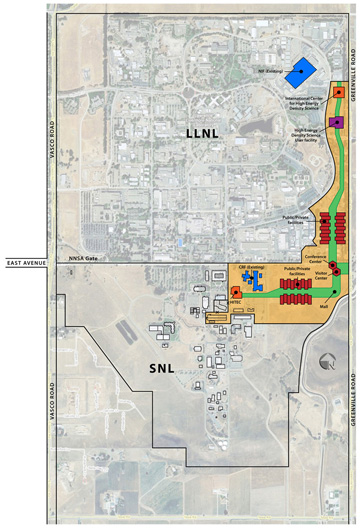
A Livermore Valley Open Campus will maximize the return on our nation’s investment in nuclear security. By leveraging the groundbreaking research of our nuclear security labs through private sector collaborations, we will bring breakthroughs to the market faster and find new solutions to the energy problem.”
Those words of support came from DOE Secretary Steven Chu in an Aug. 4 news release issued by NNSA. Chu was referring to the Livermore Valley Open Campus (LVOC) concept that is being jointly proposed by Sandia and Lawrence Livermore National Laboratory (LLNL).
In parallel with the news announcement, NNSA Administrator Tom D’Agostino and DOE Under Secretary for Science Steve Koonin signed off on a “mission need concept” document that authorizes Sandia and LLNL to move forward on developing a detailed plan for the LVOC effort. With NNSA authorization in hand, both labs will now create “phase one” of the LVOC, which will include examination of its initial infrastructure, analysis of “brown fielding” (redevelopment of land and/or facilities) needs, and creation of an operating environment to enable open operations.
Led by Sandia’s Bob Carling (8300) along with counterparts at LLNL, the Open Campus initiative is conceived as an “enabler” that will provide expanded opportunities for research collaborations between Sandia/California and LLNL and their external partners. As currently envisioned, it will consist of an approximately 50-acre parcel along the eastern edge of the LLNL and Sandia sites along Greenville Road, with LLNL’s National Ignition Facility (NIF) and Sandia’s Combustion Research Facility (CRF) serving as anchors at each end.
Easier access, greater collaboration
A more open sector, one with fewer security restrictions, says Bob, will benefit a wide range of energy-related companies, including those that focus on high-performance computing, life sciences, optical sciences, and biotechnology, which is especially important as Sandia continues to focus on transportation energy programs.
“If we wanted to arrange a visit to Sandia/California next week for Toyota’s top executives from Tokyo, for example, we simply couldn’t make it happen due to the badging processes that are in place,” Bob says. Though such processes are clearly necessary for both labs’ NNSA missions, Bob says, Sandia and LLNL both are moving in directions that will require more flexibility, particularly when foreign nationals and other uncleared visitors are involved.
The LVOC proposal is being developed in parallel with Sandia’s Hub for Innovation in the Transportation Energy Community (HITEC) program (Lab News, March 13, 2009). More effective access to the international science community and greater collaboration with industry, Bob says, are both essential to the advancement of HITEC and will be more easily achieved with a successful open campus.
‘Technotourism’ and economic impact
A number of other benefits will be derived from a Livermore Valley Open Campus, says Bob, including a potential increase in what he calls “technotourism” and economic development around the Livermore region.
“Nearly 200 scientists from around the world already visit Sandia and LLNL each year, and hundreds more would likely do so if we had an open campus in place,” Bob says. “Those researchers might have access to certain facilities for days, weeks, or months at a time, likely stimulating the regional economy when they’re here.”
The city of Livermore, Bob says, is developing strategies for increasing the technology “footprint” in the area and would like to establish the Livermore Valley as a high-tech anchor for the region. An open campus, he says, will offer companies a compelling reason to move into the area by providing smoother and more direct access to both labs’ facilities, researchers, collaborators, and technologies. Even LLNL and Sandia researchers themselves who are interested in starting spinoff companies of their own might be more inclined to remain in Livermore when an open campus is established.
Other elements of phase one of the LVOC will include evaluating alternatives, obtaining necessary approvals, and executing infrastructure modifications.